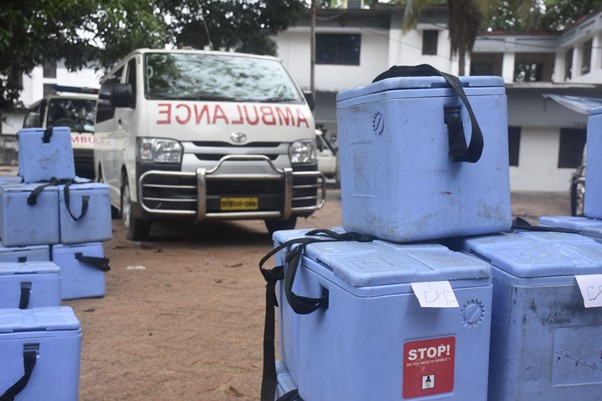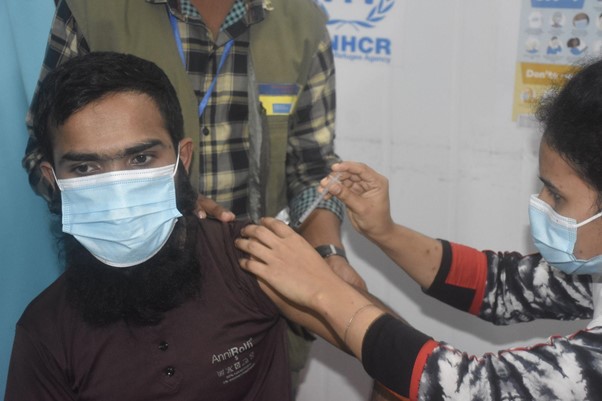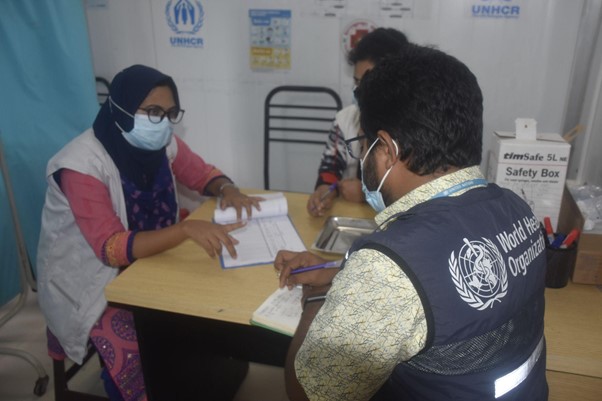
A health worker prepares to administer the COVID-19 vaccine at a health facility in the Rohingya displacement camps. May 9, 2022
©WHO Bangladesh / James Carmichael
Sahulah is feeling good. He’s just received his second dose of the COVID-19 vaccination shot and doesn’t expect any negative side effects. He’s also pleased with how quickly he was able to receive his shot.
“As soon as I arrived, I got my vaccine directly. The staff also gave me a medical mask, so I was able to receive the vaccine without any hassle.”
He is one of 379,320 Rohingya to receive at least one dose of the vaccine. Between August 2021 and February 2022, Government of Bangladesh, in partnership with WHO and others, vaccinated 88% (379,320) of the Rohingya population above 18 years of age.
Some, like Sahulah, missed their chance to receive the vaccine during the first few rounds. That’s why WHO and health-sector partners are working hard to make sure nobody is left behind.
Mobilisation through partnership
May’s vaccine catch-up campaign aimed to vaccinate anyone over the age of eighteen yet to receive their first or second dose.
In just eight days, a further 44,766 people received their shot. A total 83% of adults aged eighteen and up have now received two doses of the vaccine.
This fifth campaign leverages a well-worn mobilization network involving the Government of Bangladesh, numerous health-sector partners and WHO’s Immunization and Vaccines Development (IVD) team.
 Cool boxes filled with the Johnson & Johnson vaccine await delivery at a distribution centre. May 9, 2022
Cool boxes filled with the Johnson & Johnson vaccine await delivery at a distribution centre. May 9, 2022
©WHO Bangladesh / James Carmichael
The Ministry of Health and Family Welfare (MOHFW) of Bangladesh and its Directorate General of Health Services (DGHS) are responsible for readiness on COVID-19 vaccination. In February 2021, they released the National Deployment and Vaccination Plan for COVID-19 Vaccines (NDVP) with provisions for displaced persons.
It’s from this plan that WHO inherits its vaccination remit and targets. For all five rounds of vaccination campaigns in displaced Rohingya settings, WHO organised and coordinated the process, mapped vaccination sites, built human resource capacities and monitoring and evaluation tools.
Throughout the campaign, WHO’s 25 health field monitors have been instrumental in setting up sites and mobilising supply chains. Community Health Worker (CHW) Supervisors then set localised targets and work on the ground to ensure uptake.
Mohammed Jalal Uddin explains how his team of CHWs works in the community to encourage sensitisation and mobilisation.
“We check whether everyone in the household is vaccinated. For the CHWs, they visit every single household to check whether someone is there and not vaccinated. Then we send them [to the health facility] to get vaccinated.”
His team do the hard work of building community trust in health authorities.
“People responded negatively to the vaccine initially. But as they see others taking the vaccine, they get more motivated. Now people are more and more interested to take the vaccine.”
Reaching the most vulnerable
Displaced persons like the Rohingya Community in Cox’s Bazar are more at risk of serious consequences and mortality from COVID-19.
Close living quarters, low awareness and hygiene difficulties contribute to faster rates of infection. Without access to isolation facilities, containment is more problematic. The Civil Surgeon’s Office in Cox’s Bazar has reported 6,185 COVID-19 cases amongst the displacement camps, with a case fatality rate of 0.7%. The COVID-19 pandemic has also served to deepen threats to the wellbeing of displaced women and children.

Sahulah receives his second dose of the COVID-19 vaccine. May 9, 2022
©WHO Bangladesh / James Carmichael
Health sectors partners such as BRAC have also noted challenges with health-seeking behaviours amongst the Rohingya in particular. The Cox’s Bazar health-sector partners must constantly innovate on mobilisation models in order to reach the most vulnerable. That means supplying vaccines at different times of day and at different locations.
WHO also refines its risk communication strategies in real-time alongside the rollout, targeting areas that may see less uptake. The health sector works with local imams and Rohingya community leaders to distribute messages around vaccine safety. CHWs themselves are recruited from within Rohingya communities to build trust.
Offering continued support
Fortunately, rates of anti-vaccination sentiment remain low amongst the Rohingya community. The remaining challenges to vaccine coverage are mostly logistical—it’s about finding and mobilising the right people.
Dr Aarti Singh, WHO Emergency Consultant on Immunization, has noted, however, a rise in indifference towards the persistent dangers of COVID-19.
“To stop the pandemic,” she says, “at least 70% of the population should be vaccinated with at least two primary doses. But the declining trend of COVID-19 has led to a complacency amongst the people. They think—if there is no disease, why should I take a vaccine?”
There are fears amongst the IVD team that, if complacency is not addressed, it may lead to lower uptake rates during future vaccine rollouts. In response, WHO is modifying its risk communications and mobilisation strategies based on the perceptions around COVID-19.
 WHO reviews vaccine uptake figures alongside partners at a health facility. May 9, 2022
WHO reviews vaccine uptake figures alongside partners at a health facility. May 9, 2022
©WHO Bangladesh / James Carmichael
An immunization review is planned for May 23 under the leadership of the Ministry of Health to discuss innovative strategies on closing immunity gaps. It aims to review the situation analysis, understand barriers to vaccination and combat vaccine-preventable disease. A key focus will be how the health sector can better respond to the changing needs of beneficiaries.
WHO Representative to Bangladesh, Dr Bardan Jung Rana, attests to the need for sensitivity to health-seeking behaviours:
“Attentive, responsive service needs to be at the heart of the health-sector solution to COVID-19. That’s why this catch-up campaign is such a crucial part of the overall vaccination strategy. It’s heartening to see the milestones already achieved by the sector and how they strive to protect the vulnerable.”
As for the future, WHO stays committed to ensuring everyone is protected against COVID-19. In early June 2022, Government is planning to roll out Pfizer’s COVID-19 vaccine to the 12-17 years age group.
For Sahulah, the threat of COVID-19 is still as urgent as ever.
“All my friends and family are vaccinated…Those who did not get vaccinated will face difficulties. Because COVID-19 is infecting people and sometimes killing people. So, I wish that everyone should get the vaccine.”
For more information about the issues discussed in this feature, please contact [email protected].
